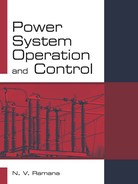4.1 INTRODUCTION
In general, both active and reactive power demands change continually with the rising or falling of load. In order to meet the active power demand, inputs to the generators i.e., steam for turbo-generators and water for the hydro-generators must be regulated. Otherwise, the machine speed will vary with consequent change in frequency, which may be highly undesirable. Similarly, the excitation of generators must be continuously regulated to meet the reactive power demand. Otherwise the voltage at various system busses may go beyond the prescribed limits. In large interconnected systems, automatic generation and voltage regulation equipments are installed for each generator because manual regulation is not feasible. While changes in active power is dependent on the internal machine angle δ and independent of the bus voltage, the bus voltage is dependent on machine excitation and independent of the machine angle δ. Change in angle δ is caused by momentary change in generator speed. The speed of the generator can be regulated by using the governor controller, which controls the inlet, increasing or reduceing the steam or water jet hitting the blades of the turbine. Similarly, the rise or fall in the terminal voltage can be controlled by the excitation controller which reduces excitation (when terminal voltage is high) or increases excitation (when terminal voltage is low) to the alternator. The terminal voltage variations are mainly due to variations in reactive power demand. Excitation voltage control is fast-acting because its major time constant is encountered due to the generator field, while the governor control is slow acting with its major time constant is contributed by the turbine and generator moment of inertia. Due to high difference in the time constants, the two controllers can be analyzed by decoupling them.

Fig 4.1 Generator controllers
This chapter provides mathematical models of turbine, speed governing system, excitation system, generator and load. These models are required for steady state analysis of generator in the coming chapters.
